That’s a Wrap for Our Seasonal Teams!
November 3rd, 2023
November 3rd, 2023
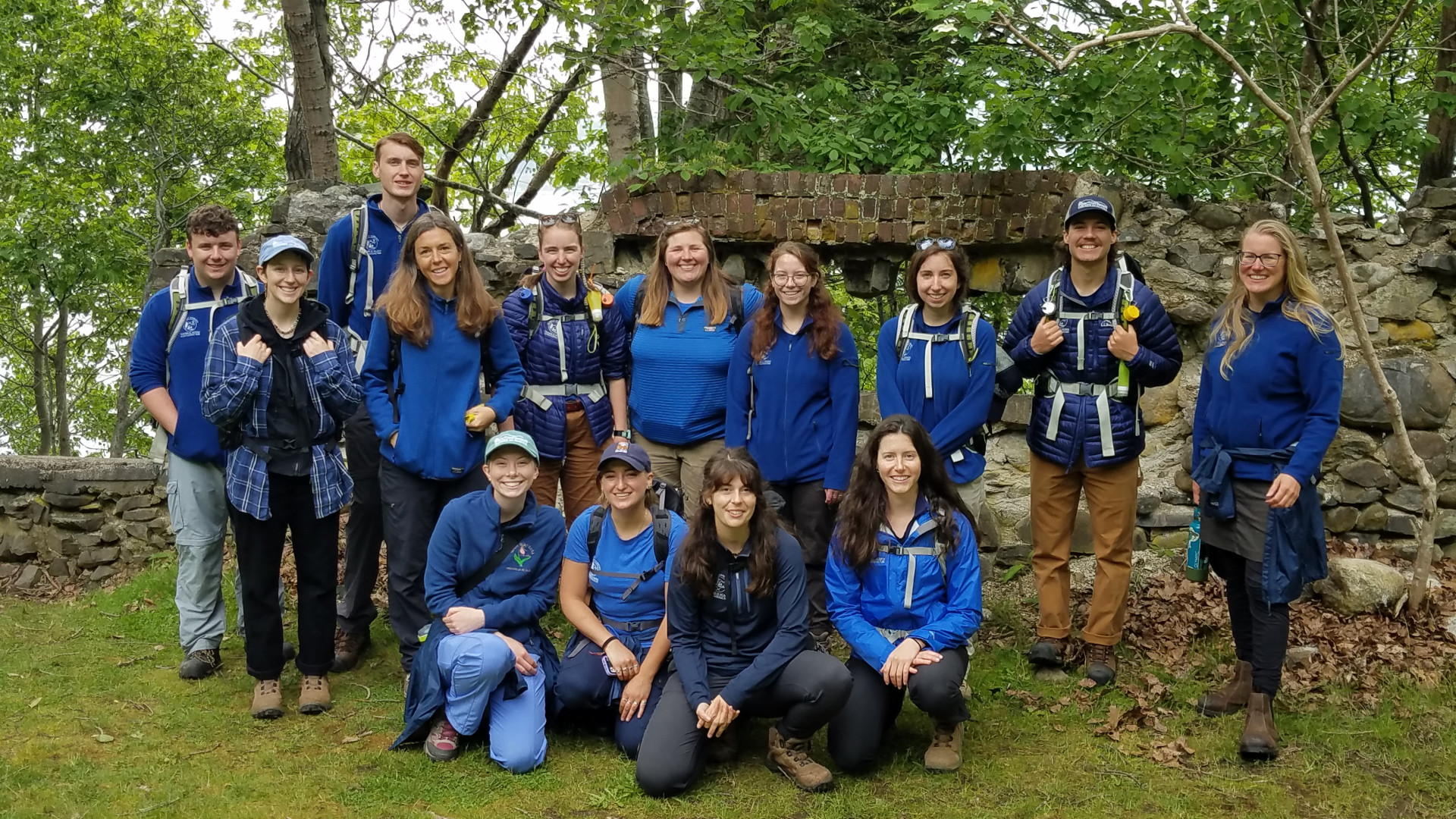
Friends of Acadia’s 2023 Seasonal Teams! Back row (L-R): Luke Fiermonti, Summit Steward; Silas Cochran, Summit Steward. Middle row (L-R): Lucie Marshall, Stewardship Crew; Kate Prisby, Summit Steward; Ellie Jackson, Summit Steward; Becca Stanley, Recreation Technician Lead; Molly O’Neil, Summit Steward; Molly Bogner, Summit Steward; Ryan Nascimento, Summit Steward; Stephanie Ley, Summit Steward Coordinator. Front row (L-R): Oleander (Ollie) Morrill, Wild Gardens of Acadia Intern; Lucy Martin, Recreation Technician; Nikki Burtis, Stewardship Crew Coordinator; Miriam Nelson, Stewardship Crew. (Photo by Stephanie Clement/Friends of Acadia)
Friends of Acadia’s Stewardship Crew, Recreation Technicians, and Summit Stewards just wrapped up their seasons in Acadia. And wowza, did they accomplish a lot.
These crews are comprised of year-round coordinators and seasonal staff who work in the field to benefit Acadia National Park and the people who come to marvel and explore. That work includes talking with park visitors about the park’s trails, cairns, and flora, helping build and maintain the trails and carriage roads, and monitoring how visitors move about the park.
This work has an immediate positive impact on Acadia, but it has far-reaching ripple effects, too. Visitors who learn about Leave No Trace from a Summit Steward will be wiser and more thoughtful users of public lands, wherever they roam. Bogwalk and fences built by the Stewardship Crew and program volunteers will guide visitors and protect fragile vegetation for decades to come. And data gathered by the Recreation Technicians helps resource managers make future decisions in Acadia.
Here’s a snapshot of the work from 2023 (to get a fuller sense of all that was accomplished, watch the End of Season video below or on Vimeo)!
Our Stew Crew does important hands-on work on Acadia’s trails and carriage roads, like cutting back vegetation, clearing drainage features, building bogwalk, tread work, weeding carriage roads, and other tasks. And they welcome loads of volunteers to help out each season, too.
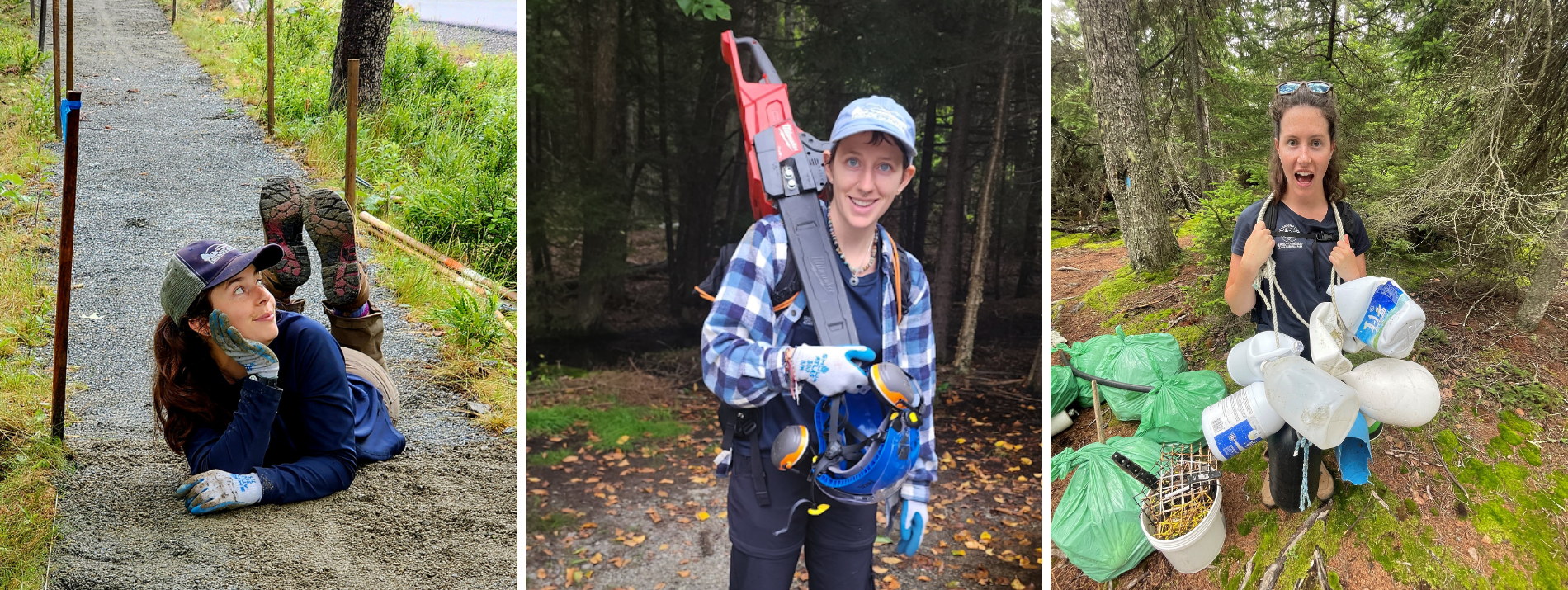
Some on-trail personality with Stewardship Coordinator Nikki Burtis (left) and Stewardship Assistants Lucie Marshall (center), and Miriam Nelson (right).
While inclement weather thwarted a handful of Drop-In Volunteer Program days, especially early in the season, and the Drop-In location changed this year due to construction happening at Park Headquarter (hurrah for a new Maintenance Facility!), this crew accomplished a lot. This year’s Stewardship Crew was once again led by Stewardship Coordinator Nikki Burtis with Stewardship Assistants Lucie Marshall and Miriam Nelson – and was complemented by 13 Volunteer Crew Leaders (and another 6 who became VCLs during the season) and a host of drop-in and group volunteers. (Learn more about the Stewardship VCLs: Meet Acadia’s Stewardship Volunteer Crew Leaders)
The Drop-In Volunteer Stewardship program completed 2,296.5 hours of work, which included fence building, trail and carriage road drainage clearing, brushing in trails to deter the use of social trails, and brushing out – trimming back vegetation to keep the path easy to see and navigate. Some notable projects include: the completion of the bogwalk on the trail around Upper Hadlock Pond, a split rail fence on the stairs at Jordan Pond, and a fence replacement at the ADA entrance at the park’s Hulls Cove Visitor Center.
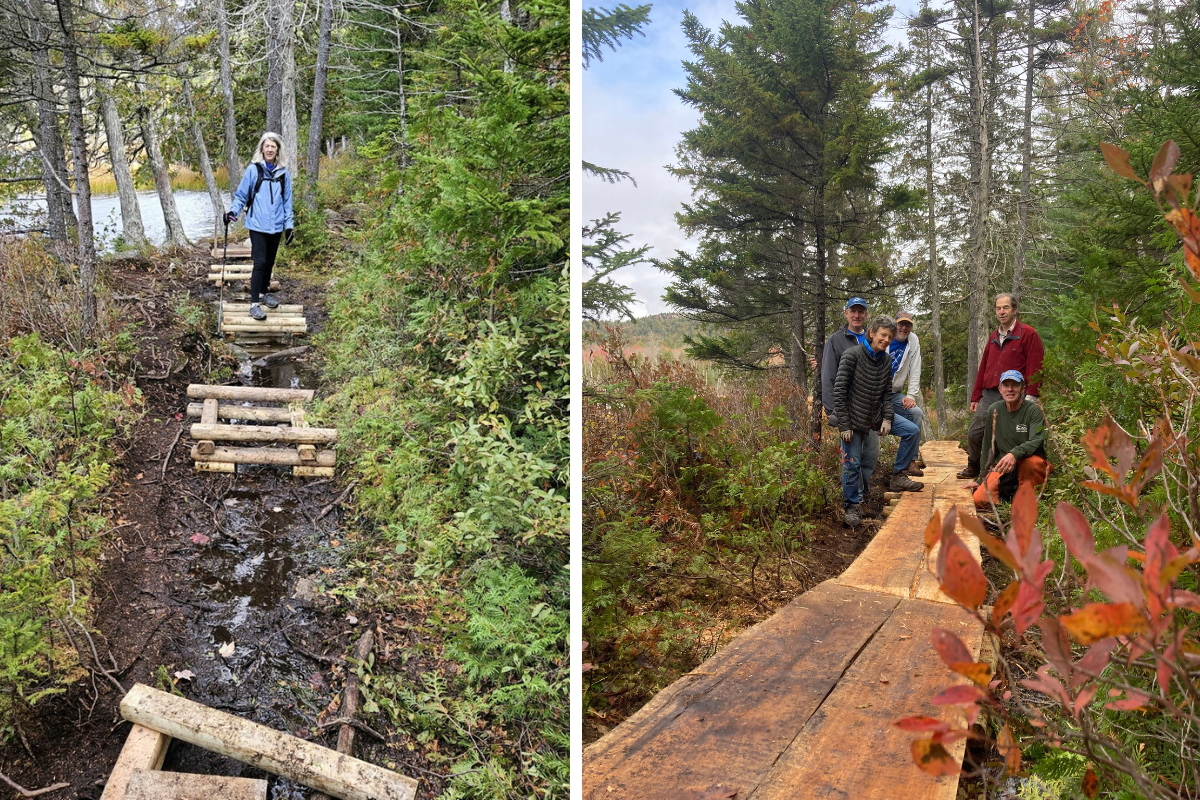
Before (left) and after of the Upper Hadlock Pond boardwalk.
The Stewardship Crew also welcomed 20 service groups – some coming for a day, others coming for a week! Collectively they accomplished 1,111 of work. Among this season’s groups were folks from Frost Valley YMCA in New York who volunteered for 5 days; Road Less Traveled, a Maine-based adventure and service group for middle schoolers, who came for 3-4 days and helped carry a lot of big pieces of wood on the Maple Spring Trail; and a local chapter of My Peak Challenge, who focused their efforts cleaning up Ocean Path near Otter Point and a beach cleanup at Otter Beach.

One of this year’s service groups was the Road Less Traveled, a Maine-based adventure and service group for middle schoolers, came for 3-4 days and helped carry a lot of big pieces of wood on the Maple Spring Trail.
Recreation Technicians work in the park gathering data about how visitors move about the park (where they go, when they go, and what they do when they get there). This valuable data informs future decisions made by resource managers.
>Read more about work of a Recreation Technician: Gathering Data to Understand Park Visitors
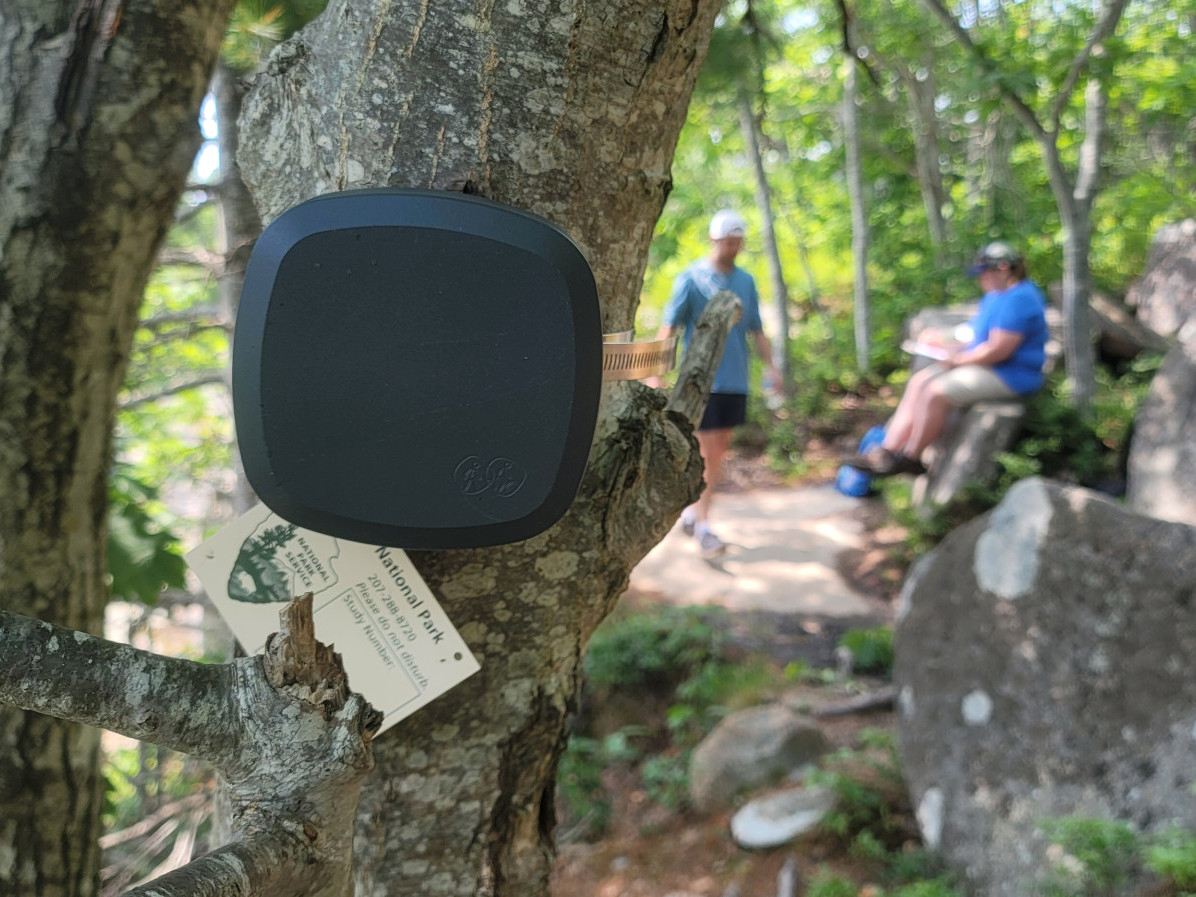
Recreation Technician Lead Becca Stanley counts hikers on the Beehive Trail. Her count is compared with the nearby trail counter to validate the counter’s accuracy. (Shannon Bryan/Friends of Acadia)
This year’s Recreation Technicians were Becca Stanley, Recreation Technician Lead, and seasonal Rec Techs Laurel Shanks and Lucy Martin. Their data collection utilizes a good deal of equipment, including 19 traffic counters, 7 trail counters, 7 carriage road counters, and 1 camera, as well as hourly validations, monthly downloads, and maintenance and repairs. Collaborative research was also conducted with Worcester Polytechnic Institute (WPI), Acadia Youth Conservation Corps. (AYCC), Acadia Teacher Fellows, SUNY ESF, and a Bat and Light Study working with Penn state and other universities to deepen the understanding of bats and various lighting treatments on the carriage roads.

Rec Techs Laurel Shanks (left, checking a trail counter) and Lucy Martin (right, working with the Acadia Youth Conservation Corps) in the field.
To learn more about visitor use when it comes to the free Island Explorer shuttle, Laurel Shanks conducted research to discover why some visitors don’t use the service. She inquired with car-driving visitors about their awareness and perceptions of the Island Explorer and the obstacles that prevented them from riding the shuttle, and whether those barriers were things that could be addressed. Learn more about Laurel’s research and findings in the video below.
Lucy Martin worked as liaison for night sky research, meeting with researchers, local stakeholders, and industry professionals. Her project focused on better understanding future light management and she produced a 45-page report on the park’s current dark sky status and recommendations moving forward.

Presenting their findings. Left: Lucy Martin presents her dark sky recommendations. Right: Laurel Shanks presents her findings during a poster session at the Science Symposium. (Photos by Becca Stanley/Friends of Acadia)
Friends of Acadia’s Summit Stewards spend thousands of hours each summer and fall on Acadia’s summits and trails, answering visitor questions, conducting basic trail maintenance, repairing cairns, removing visitor-built cairns and rock art, and responding to emergencies. This year’s crew was again led by Stephanie Ley, coordinator alongside Kate Prisby, Summit Steward Lead; and Summit Stewards Molly O’Neil, Ryan Nascimento, Molly Bogner, Ellie Jackson, Luke Fiermonti, and Silas Cochran.
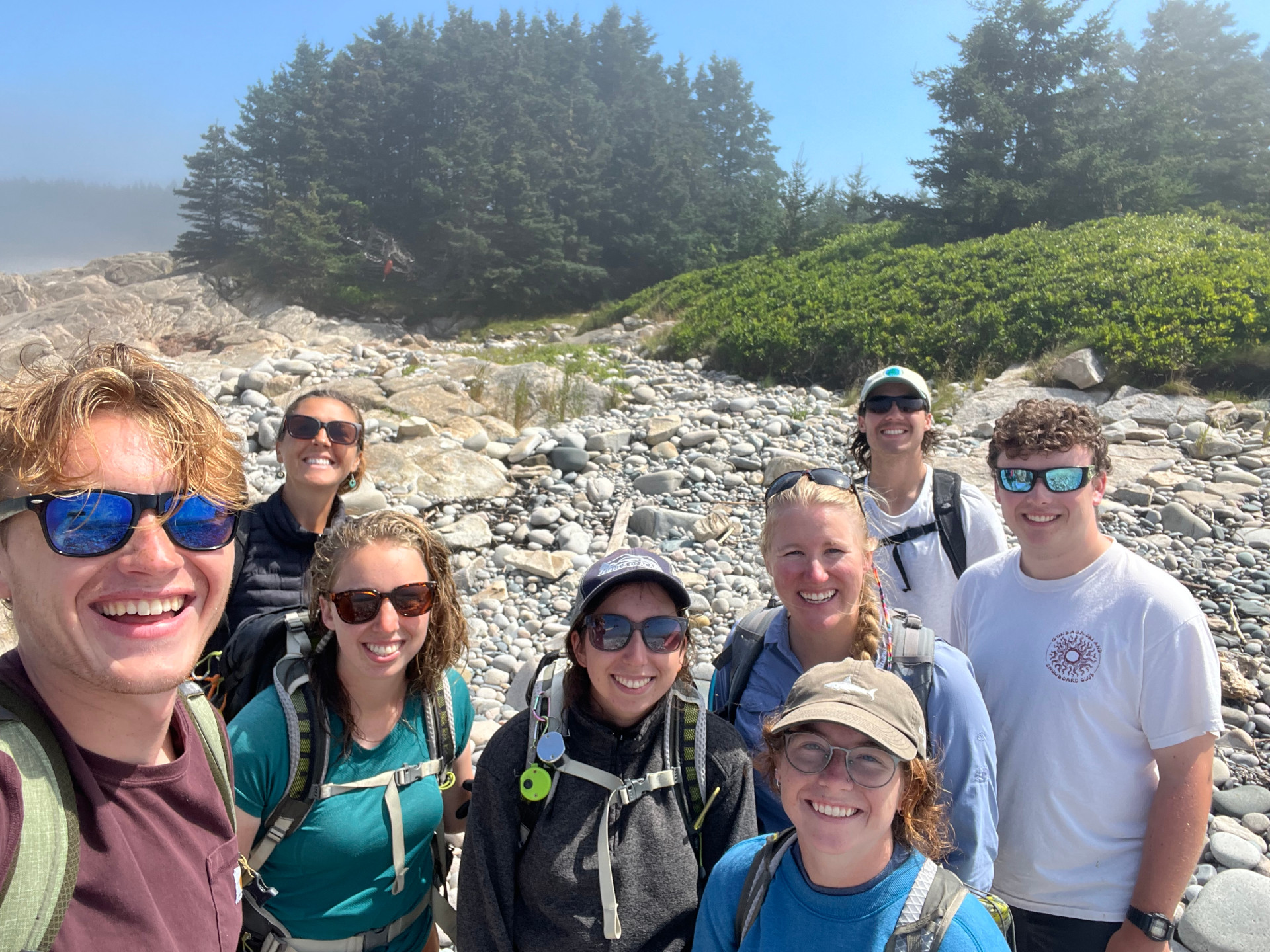
Summit Steward selfie! (L-R): Silas Cochran, Kate Prisby, Ellie Jackson, Molly Bogner, Stephanie Ley (without hat), Molly O’Neil (front in hat), Ryan Nascimento (far back), and Luke Fiermonti. (Photo by Silas Cochran)
Over the season, this crew has 20,605 visitor contacts. Those conversations have wide-ranging impact, from helping park visitors be more thoughtful stewards of the park to helping point them in the right direction to a trailhead. Leave No Trace principles are a big part of many of those conversations, accounting for 9,394 of those interactions with visitors. They also rebuilt 1,151 cairns and spent 543 hours “postering” – talking with visitors at specific locations about pertinent topics (for example, talking about the vegetation restoration work taking place on Cadillac Mountain, where Summit Stewards have a strong presence throughout the season).
Three Summit Stewards also worked with members of the Acadia Youth Conservation Corps to get them Leave No Trace certified, and Summit Stewards themselves had trainings of their own, including chainsaw certification and cultural competency trainings with Wabanaki members.

Left: Viewed from the fire tower, Luke Fiermonti talks with hikers. Right: Silas Cochran posters at Jordan Pond. (Photo by Stephanie Ley/Friends of Acadia)
The also assisted with 20.5 hours of search-and-rescue (SAR) and 53 visitor assists (which includes things like providing extra water to a hiker, helping with basic first aid, or assisting a visitors who’s lost).
One highlight of the season was opening up the fire tower on Beech Mountain over the weekends and welcoming visitors to climb up and learn about the fire of 1947, which changed the landscape of the park. And let’s not forget how much soil this group hiked up to the summits of Penobscot and Sargent Mountains this summer during the Soil on Summits event and throughout the season. Together they brought a whopping 400 pounds of soil up – and every pound is being used as part of the park’s summit restoration work. (Read more about that: Volunteers Hike With Soil During Save Our Summits Event)
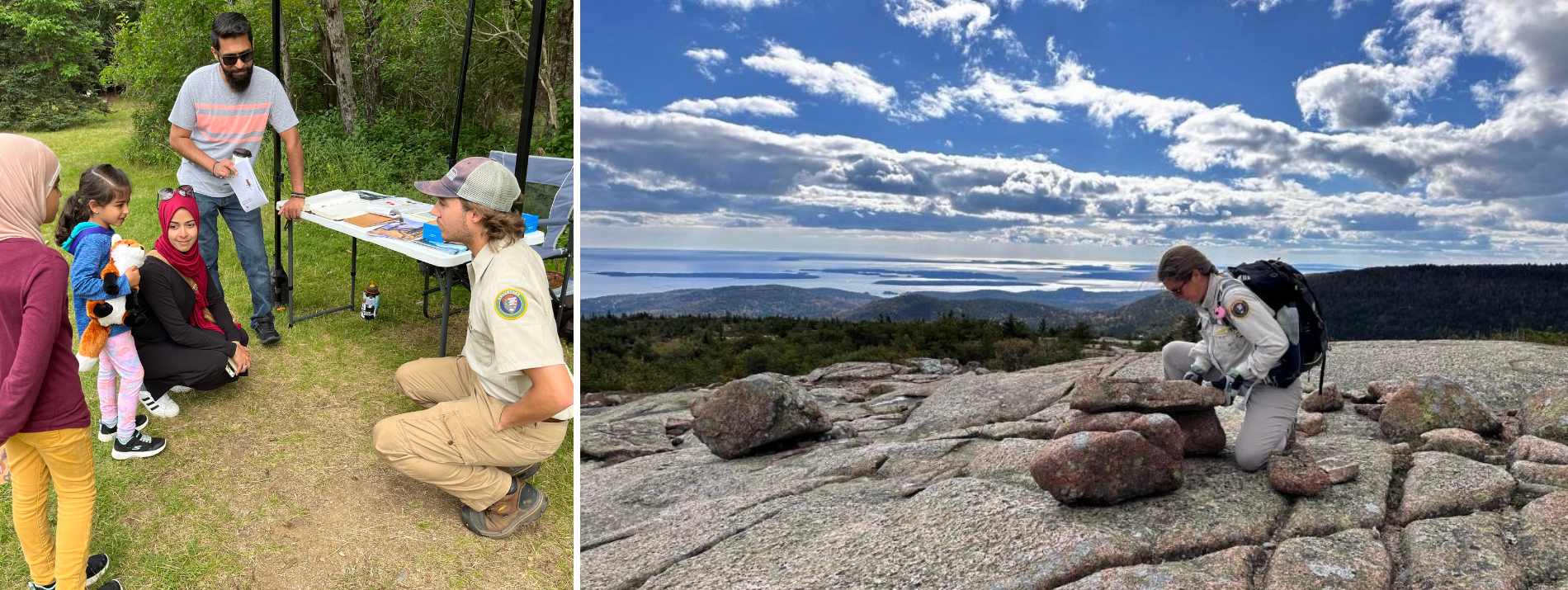
Ryan Nascimento talks to a family at Compass Harbor. (Photo by Stephanie Ley/Friends of Acadia). Right: Kate Prisby rebuilds a cairn on South Cadillac.
Huge thanks to the Stewardship Crew, Recreation Technicians, and Summit Stewards for their hard work and good humor this year. And to every Friends of Acadia volunteer, donor, and supporter who helps make this work possible.